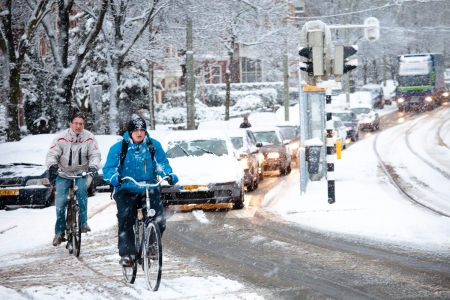During showers, snow and hail lead to many of the same problems as rain, namely longer braking distances, reduced visibility due to the precipitation itself and from splashing water. (Wet) snow and hail showers more often than rain result in a slippery road surface with associated negative consequences for braking distance and road grip. When snow settles, the road surface will remain slippery, with consequences for road safety (see the question How many crashes occur due to slippery roads? en How many crashes occur on or due to slippery bicycle tracks?).
Much less research has been done on the effect of (wet) snow and hail than on the effect of rain. The research that has been done on snow generally does not distinguish between the effects of the precipitation itself and the effects of the resulting slipperiness. Moreover, the effect of snow on mobility is not considered, or only to a limited extent. Analysis of seven studies from Belgium, the Netherlands and Scandinavian countries on the effect of different characteristics of snow (e.g., snowfall, depth of snow, presence of snow, number of snowy days [4]) does not allow for an unambiguous conclusion. Positive effects (fewer crashes) were slightly more often reported than negative effects (more crashes). Especially the first snow after a period without snow appears to result in a higher crash risk. Adapting behaviour to snowy conditions will help reduce or eliminate a(n) (negative) effect on the number of crashes. What is also important is that snow reduces mobility, including that of more vulnerable road users such as pedestrians, cyclists, motorised two-wheelers and older people [1]. A Finnish study [5] concludes that in Finland crash risk in snow, i.e., corrected for mobility, is more than twice the average crash risk (see the question Which weather conditions are most common in crashes and how dangerous are they?). In Finland apparently, behavioural adjustments are insufficient to compensate for the more dangerous driving conditions.
